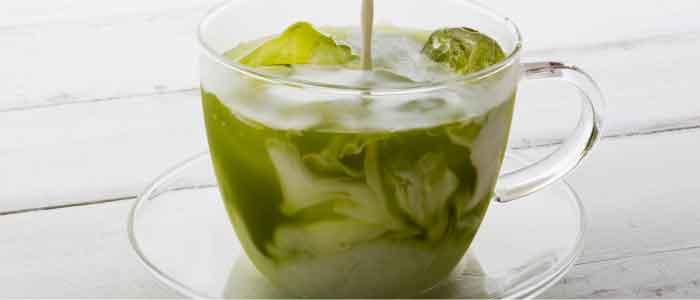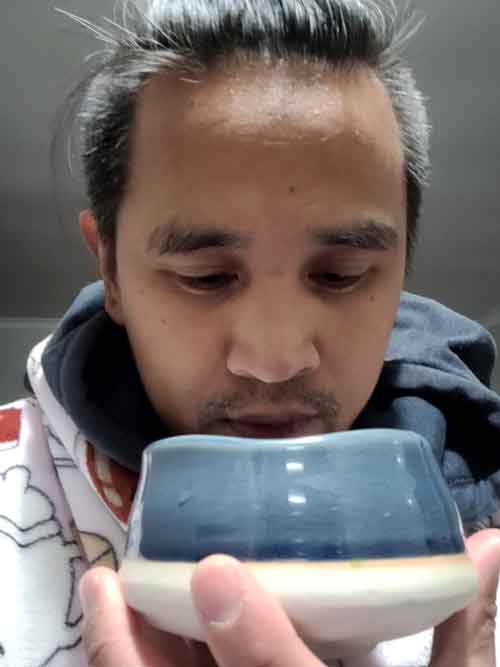Alrighty then, tea enthusiasts, it’s time to address the elephant in the tea room: “Can you use ceremonial grade matcha for lattes?” Ah, the age-old question that’s probably been causing a furrowed brow or two. Let’s dive into this frothy green conundrum, shall we?
Matcha lattes, that velvety, creamy delight that has taken the beverage world by storm. From hipster coffee joints to your Instagram feed, these emerald concoctions are everywhere. As its popularity surges, so does the great matcha latte debate, with the heart of the matter being whether one should dare to use ceremonial grade matcha for lattes.
Before we delve deeper into this steaming cup of controversy, let’s chat a bit about what ceremonial grade matcha is. It’s the Beyoncé of the matcha world — the crème de la crème. Produced with the utmost care, it comes from the finest, youngest tea leaves, ground into a smooth, fine powder. It’s the star of traditional Japanese tea ceremonies, and it’s so good that it’s typically enjoyed pure, with just a hint of hot water.
With such an all-star ingredient, the question remains — should it be sharing the spotlight with milk and sugar in your latte? Stick around, my tea-curious friends, as we delve further into this frothy mystery.
Understanding Ceremonial Grade Matcha
Picture this: a red carpet unfurls, and strutting down that plush path is none other than the star of our show, ceremonial grade matcha. It’s no ordinary tea, folks. It’s the A-lister of the green tea universe.
Ceremonial grade matcha is harvested once a year from the first flush of spring growth, often referred to as the “first harvest”. The youngest, tenderest leaves are chosen, shaded from direct sunlight for about three weeks before they’re harvested. This shading process boosts the leaves’ chlorophyll levels, giving our matcha its vibrant, feel-good green color.
The leaves are then steamed, air-dried, and carefully deveined and destemmed, leaving only the pure leaf flesh or “meat” behind. This leaf “meat” is then stone-ground to a super fine powder that has a texture similar to high-quality baking flour.
In contrast, other grades of matcha, like culinary or ingredient grade, are often harvested from later flushes, made from older leaves, and ground by machine. These differences result in a less vibrant color, slightly rougher texture, and a more astringent taste.
So, what does a sip of ceremonial grade matcha taste like, you ask? Imagine the ultimate sweet spot (no pun intended) between “umami” and “sweet”, with a whisper of grassy freshness. It’s an all-natural, green tea flavor that’s smooth, mellow, and remarkably rich.
There’s an unmistakable, delicate sweetness to it that’s as rare as a left-handed unicorn. And let’s not forget the finish — it’s clean, velvety, and lingers just long enough to have you hankering for the next sip. It’s the kind of flavor that’s deserving of a standing ovation or at the very least, a slow clap.
In contrast, other grades of matcha might have a more pronounced bitterness or lack that velvety, umami-packed punch. So, knowing all this, would you want your ceremonial grade matcha to tango with milk and sugar in a latte, or prefer it solo? Stick around as we delve into the pros and cons next!
Why Ceremonial Grade Matcha is Typically Reserved for Traditional Tea
Alright, green tea enthusiasts, let’s turn back the pages of the tea leaf tome and delve into the traditions. See, ceremonial grade matcha has been the belle of the ball in Japanese tea ceremonies for centuries, steeped (pun intended) in tradition and respect.
In these ceremonies, the preparation and presentation of matcha is a quiet, meditative process, a little like yoga for your tea-loving soul. The matcha is measured with a bamboo spoon (or “chashaku”), whisked with a bamboo whisk (or “chasen”) in a traditional tea bowl (or “chawan”).
And the matcha itself? It takes center stage, enjoyed pure and simple, with just hot water added. No milk, no sugar, no frills. It’s a little like a solo performance by your favorite artist — no backup dancers, just raw talent and passion in the spotlight.
So, why do we usually keep this superstar of a tea leaf away from the other ingredients in the pantry? Well, when you’ve got something as carefully crafted and delicately flavored as ceremonial grade matcha, adding other ingredients is like putting ketchup on a perfectly cooked steak — it just seems a tad unnecessary.
Mixing ceremonial grade matcha with milk, sugar, or other flavors can overshadow its subtle sweetness and rich umami notes. It’s like inviting a violin to a rock concert — its nuanced melody could get drowned out by the louder instruments.
Not to mention, the higher price point of ceremonial grade matcha (given the careful and laborious production process) means that for everyday use, like a morning latte, it might feel a bit like popping a vintage bottle of champagne for a casual Tuesday night dinner.
Does that mean it’s a crime to use ceremonial grade matcha in a latte? Absolutely not! It’s your matcha party, and you can latte if you want to! But understanding the what, why, and how of ceremonial grade matcha can help you make the most of this green tea rockstar. So, stay tuned as we weigh the pros and cons of using ceremonial grade matcha for your beloved latte.
Making Lattes with Ceremonial Grade Matcha
Now, let’s talk about our matcha A-lister trying its hand (or leaf?) at a latte. The key question: Is it a “yay” or a “nay”?
Pros and Cons
On the pro side, using ceremonial grade matcha in your latte is like turbocharging it with quality. The flavor is richer, smoother, and less bitter than other grades of matcha. Your latte will taste like it’s been given the royal treatment, and the vibrant green color is an Instagram dream come true.
But let’s look at the cons. While your taste buds might throw a party, your wallet might feel a pinch. Ceremonial grade matcha comes with a steeper price tag due to its high-quality processing. Also, the subtle nuances of ceremonial grade matcha could potentially get overshadowed by the milk and sweetener, making it a bit like buying a sports car only to drive it in rush hour traffic.
Still on board with using the Beyoncé of matcha in your latte? Great! Here’s a simple guide on how to create a matcha latte masterpiece:
- First, scoop a teaspoon of UJIHA ceremonial grade matcha into your favorite mug. You can adjust the amount to taste, but remember, this is premium stuff, so a little goes a long way!
- Add a tiny bit of hot (not boiling) water — just enough to create a paste with the matcha. This is your “matcha shot”.
- Smooth it up! Ideally, with a bamboo whisk if you’ve got one, but a regular whisk will do. You’re looking to eliminate any clumps and create a smooth paste.
- Warm up your milk of choice — cow, almond, oat, soy, you name it. You’ll need about a cup. And if you’re a fan of froth, give it a good frothing with a frother or simply by shaking it in a jar with a secure lid.
- Now comes the magic. Pour your warmed (and optionally frothed) milk over your matcha shot. As the green and white blend, you’ll see a whirl of emerald spirals. Sit back, snap a picture (because, Instagram), and enjoy the show.
- Sweeten to taste, if desired. A little honey or agave syrup can be a sweet addition, but remember, the ceremonial grade matcha brings its own delicate sweetness.
- Stir, sip, and savor! You’ve just created a latte worthy of the finest cafés, right in your own kitchen.
- So, there you have it. The pros, the cons, and the how-to of using ceremonial grade matcha for lattes. The ultimate decision is yours, my matcha-loving friend. Latte on!
When it Makes Sense to Use Ceremonial Grade Matcha for Lattes
So, when does it make sense to whip out the ceremonial grade matcha for your lattes? Let’s mull over a few scenarios, shall we?
First, consider the special occasions. We’re talking about when you want to impress that discerning aunt who considers herself a tea connoisseur, or when you’re hosting a themed tea party for your fellow matcha-lovers. Using ceremonial grade matcha in these instances is like getting out the fancy china — it adds an extra level of wow.
Second, it’s worth considering if you’re sensitive to bitterness. Lower grades of matcha can have a more pronounced bitterness that milk and sweetener may not completely mask. If you’re all about that smooth, sweet, umami-packed flavor, then using ceremonial grade matcha in your latte could be a taste bud game-changer.
Now, let’s talk about the big C — Cost. Ceremonial grade matcha is pricier, no doubt. But here’s a question to steep on: how much is an extraordinary flavor experience worth to you?
If you’re a casual matcha latte sipper, you might be perfectly content with a lower grade matcha that still gives you a decent latte and leaves your wallet breathing a sigh of relief. But, if you’re a matcha devotee with a palate for the finer things in life, that extra cost might be a worthy investment for an unrivaled taste experience.
In the grand tea scheme of things, whether you choose to use ceremonial grade matcha for your lattes boils down to personal preference. Your tastebuds, your budget, and your love for all things matcha get to be the judge. So, take a sip, make a choice, and keep on enjoying the matcha journey!
Conclusion: To Latte or Not to Latte with Ceremonial Grade Matcha
Alright, my tea comrades, we’ve been on quite the matcha adventure. We’ve dived into the verdant world of ceremonial grade matcha, understanding what makes it the shining star of the tea universe. We’ve pondered on the age-old question, “Can you use ceremonial grade matcha for lattes?”, and mused over the pros and cons.
From the distinctive, umami-rich flavor and smooth texture of ceremonial grade matcha, to its traditional solo performance in Japanese tea ceremonies, we’ve covered all bases. We also embarked on the potentially controversial journey of turning this elite tea into a frothy, creamy latte, considering the cost, the taste experience, and when it might make sense to indulge in this premium tea luxury.
In the end, my fellow matcha enthusiasts, the latte ball is in your court. It’s a personal choice, just like how you take your coffee or whether you prefer the window seat on a plane.
Consider your flavor preferences, your sensitivity to bitterness, your wallet’s comfort level, and how much you value that premium matcha experience. If you fancy a top-tier tea experience with every sip, go ahead and dive into that ceremonial grade matcha latte. If you’re content with a good, solid latte without the bells and whistles, stick with a culinary or latte-grade matcha.
Whatever you decide, remember that the journey is just as important as the destination. So keep exploring, keep savoring, and keep on falling in love with the magical world of matcha. Here’s to your next great cup of tea! Or should I say, latte?


